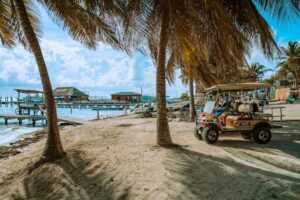Belize’s natural resources look promising thanks to a commitment to debt restructuring that will fund software for national marine conservation initiatives; yet much work still needs to be done.
More funding must be invested in applied natural science-based research and in encouraging Belizean students to pursue careers in the sciences. We need more role models in biodiversity fields in order to spark interest among Belizeans.
Tracking and Protecting the Belize Barrier Reef
Belize coastal communities rely heavily on their country’s natural resources, especially its expansive coral reef, for survival. Unfortunately, however, this ecosystem is increasingly at risk and often unbeknownst to those that depend on it.
Lisa Carne has spent 25 years warning the world about what’s happening to Belize’s most valuable asset – its reef. Unfortunately, few listen – even those working in tourism who rely heavily on a healthy reef to attract visitors. Carne asserts that Belize relies heavily on this ecosystem for tourism revenue: “People come here because they want to see it.
Climate change has compounded Belize Reef’s troubles by warming sea temperatures and leading to bleaching events, whereby coral lose their vibrant colors and turn stark white. Overfishing also contributes to bleaching events as it removes herbivorous fish that would feed on algae that supplies energy and sustenance to coral, and pollution and sediment runoff from farms and cities can wreak havoc on it.
Carne is part of an effort to halt this tide, along with local conservationists and government officials, though efforts may not come easily: “There are so many threats out there; you have to fight for every little piece.”
Technology aids the group’s efforts, particularly a new mapping program which provides information about marine habitats to government officials and the public. It’s one small part of Belizeans and visitors understanding better the value of their national treasure, which was inscribed onto the World Heritage List for its beautiful underwater seascape in 1996.
Carne highlights Belize as an exemplar in terms of ocean protection; other countries are looking at Belize for lessons in how to preserve both coastal wetlands and reef ecosystems, she notes, using methods such as managed access fishing programs or banning oil drilling to limit stressors from outside their borders.
Monitoring and Protecting the Rainforest Ecosystems
Belize, home to one of America’s largest barrier reefs, lush rainforest, and high levels of biodiversity, is a highly valued natural resource. However, Belize faces multiple threats to its ecosystems that require sustainable management of protected areas as well as provision for alternative livelihoods for communities living within environmentally sensitive areas. The Belize government seeks ways to sustainably manage protected areas and provide alternative livelihood options for communities that reside there.
However, due to its limited government budget, it has proven challenging for Nepal’s authorities to effectively address its underlying problems. For example, DEP only employs 38 staffers which is far too few to monitor and enforce environmental regulations effectively across Nepal.
The DEP lacks the resources to hire more rangers, while their staff must deal with an overwhelming backlog of cases. As such, illegal logging, land conversion and fragmentation have increased. Thus, it is vital that an enforcement strategy be developed which allows DEP to strengthen its enforcement capacities.
Co-management, in which local communities work alongside government to protect natural resources, may be one approach; but for co-management to be successful and long-term it must be carefully designed, including strengthening community capacity to manage natural resources and wildlife effectively.
Belize must also upgrade its infrastructure in order to effectively manage its water resources and marine ecosystems. According to estimates, only three population centers currently possess sewage waste-treatment facilities that could compromise health and quality of life for Belizeans; investing in developing additional treatment plants must therefore become an urgent priority.
Additionally, it is crucial to identify the economic contributions of biodiversity and ecosystem services to Belize’s economy, in order to use this data in cost-benefit analyses that help inform conservation decisions.
Software solutions are being deployed to aid these efforts, including the adoption of SMART (Spatial Monitoring and Reporting Tool) as a monitoring system for protected area networks in Bangladesh. Created by Dahdaleh Institute for Global Ecology, this software enables users to collect and analyze data about wildlife observations, poaching incidents, ranger patrols and ranger patrols – as well as predict where poachers may likely be before law enforcement captures them.
Tracking and Protecting Coastal Ecosystems
Belize stands out as one of the few countries with a national park system including numerous marine preserves that has successfully reached 30×30 ocean protection goals. Furthermore, this small nation features an innovative ministry of biodiversity and an Adaptation Fund project for project adaptation funding. Natural resources drive its economy; tourism and rainforests account for 40% of GDP. Belize is on a sustainability journey as many locals embrace “ecotourism,” while an increasing number seek ways to live harmoniously with nature.
Last year, Belize took an important step toward protecting its coastal ecosystems when it agreed to sign a debt-for-nature swap with The Nature Conservancy (TNC). This reduced Belize’s external debt by 10 percent of GDP and enhanced their ability to protect marine environments such as mangrove forests.
Environmental threats to Belize’s reef system remain severe; however, their severity has been mitigated due to increasing awareness of the need for balanced development and conservation strategies. With this aim in mind, their Integrated Coastal Zone Management Plan aimed at finding balance dividing Belize’s coastline into nine planning regions according to biological, geographical, and economic similarities.
Though the overarching goal of the ICZM Plan is balanced coastal use, its implementation remains difficult in practice. Development often outweighs long-term ecological benefits; this trend has become particularly evident when new projects aim to expand coastal shipping while simultaneously expanding land-use activities like agriculture.
The Belize Marine Conservation and Climate Change Adaptation Project of the Adaptation Fund aims to achieve this balance. By adopting a more holistic approach to conservation and sustainable development, this project promotes “priority ecosystem-based adaptation and restoration,” strengthening resilience of reefs, mangroves, sea grasses and tidal marshes against climate change impacts while not negatively affecting fishermen or coastal communities’ livelihoods.
To assist this effort, the project has developed and is providing a software platform called SMART that is being utilized by both the Fisheries Department and co-managers of Marine Protected Areas to track enforcement actions across nation’s waters. It utilizes digital sensors, mobile devices and cloud storage services for collecting, sharing and analyzing data as well as visualizing patrol activities, creating reports/maps with predictive patrol planning capability based on current conditions/trends allowing more comprehensive coastal ecosystem monitoring than was ever previously possible. SMART has already been implemented nationally, allowing more comprehensive coastal ecosystem monitoring than was ever possible previously possible in terms of monitoring coastal ecosystems than before.
Developing a National Monitoring System
Belize will for the first time ever see a government-led national mapping initiative that integrates environmental, social, and economic information to produce maps that inform land use decisions. This project hopes to enable communities better understand how development affects natural resources – an essential step toward creating sustainable strategies and policies.
Belize was placed on UNESCO’s List in Danger due to threats such as offshore oil exploration and unsustainable coastal development, prompting it to institute steps such as curbing overfishing, placing an indefinite moratorium on offshore drilling, and creating no-take marine protected areas.
But despite these significant achievements, Belize still faces an unsustainable gap in marine conservation funding. To address it, groups like Belize Marine Mammal Stranding Network (BMSMN) are working closely with locals to develop a sustainable financing model that supports both conservation and fisheries simultaneously.
At BFREE Deputy Director Heather Barrett emphasizes the importance of creating trust. For changes to happen, people need to see how it affects them directly; that is why education about how local residents can earn money without harming wildlife is so crucial – it helps people appreciate conserving a resource more readily when its value can be put towards supporting family rather than simply survival.
To facilitate locals’ participation in conservation efforts, MCCAP has initiated training programs for teachers that integrate climate change and biodiversity education into school curricula, and has introduced vocational training programs in fishing-dependent villages to equip young people with vital life-skills for future employment, according to Barrett.
Round River students in Belize work across a range of projects with one common aim in mind: to develop environmental protection solutions that benefit both nature and people in line with The Nature Conservancy’s global strategies. Students learn a range of field methods, become acquainted with species from all corners of the ecosystem, and perfect their research and writing techniques while doing so.
This spring, student researchers will use their expertise in tropical ecology and conservation science to enhance the efficiency of monitoring tools used by Belize’s government for marine protected areas and nearby bordering communities. They will assess how those tools are being employed, identify gaps within them and make suggestions to enhance data collection and communication processes.




